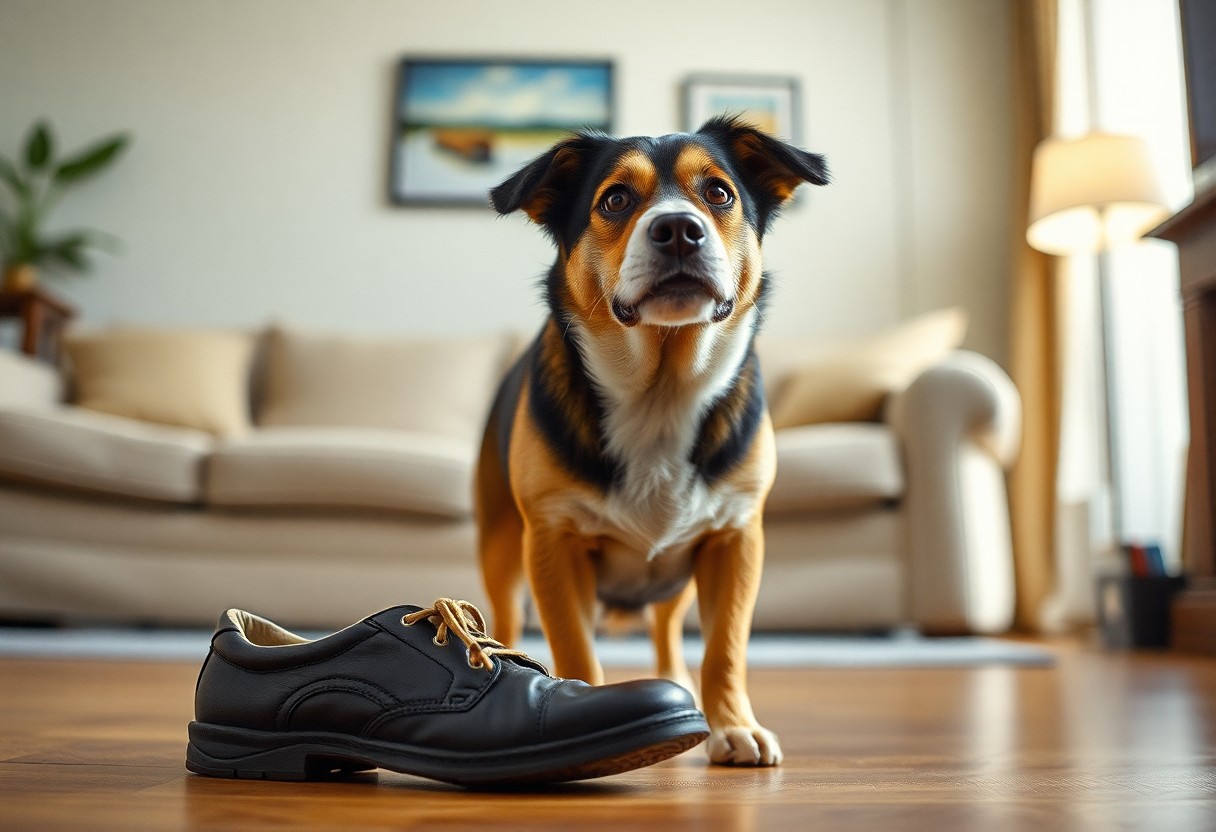With a dog’s soulful gaze and expressive demeanor, you often wonder if they truly feel guilt when mischief occurs. Understanding your dog’s emotional landscape is important for fostering a harmonious relationship. While some researchers argue that what appears to be guilt may actually stem from a dog’s ability to read your body language and react to your emotions, acknowledging their feelings can lead to more effective communication and training. Dive into the fascinating world of canine emotions to uncover the truth about your furry friend’s guilt response.
Understanding Canine Emotions
While it’s common to believe that dogs experience guilt, understanding their emotions requires a deeper look into their behavior and communication. Dogs are social creatures, and their emotional lives are complex. By recognizing the signs of various feelings, you can enhance your bond with your furry friend and respond appropriately to their needs.
The Science of Dog Emotions
About 50% of your dog’s emotional experience is rooted in their instinctual responses, while the other half is shaped by their interactions with you and their environment. Scientific studies have revealed that dogs possess emotions similar to humans, such as happiness, fear, and even jealousy. By understanding these emotions, you can create a more fulfilling relationship with your canine companion.
Distinction Between Guilt and Other Emotions
Among the various emotions your dog may exhibit, distinguishing between true guilt and other feelings can be challenging. What you interpret as guilt might actually be a response to fear, anxiety, or submission rather than a conscious awareness of wrongdoing.
This distinction is important for responsible pet ownership. When you observe your dog behaving in ways you deem guilty, like cowering or hiding, it may indicate they are reacting to your tone or body language instead of truly understanding their actions. Educating yourself on your dog’s emotional responses enables you to reinforce positive behaviors and foster a trusting relationship, ultimately supporting their emotional well-being.
1. Dogs exhibit behaviors resembling guilt after misdeeds.
2. Guilt response is often a learned behavior.
3. Behavior varies among individual dogs and situations.
4. Dogs understand human emotions, influencing their reactions.
5. Positive reinforcement encourages desirable behaviors over guilt feelings.
6. Misinterpretation of dog behavior can lead to confusion.
Behavioral Signs of Guilt in Dogs
You may have noticed your dog displaying certain behaviors that seem to indicate guilt after they’ve misbehaved. Common signs include cowering, avoiding eye contact, or tucking their tail between their legs. These behaviors can often lead you to believe that your dog understands their wrongdoing, but it’s crucial to explore what these signals really mean.
Common Misinterpretations
Behavioral signs often lead to misinterpretation of your dog’s emotional state. The avoidance behaviors, such as hiding or acting submissive, frequently stem from a dog’s desire to please you and avoid your anger, rather than an understanding of guilt.
True Indicators of Guilt
At the core of understanding your dog’s emotional responses, true indicators of guilt may actually be linked to their fear of your reaction rather than a moral understanding of right and wrong. While dogs do experience emotions like anxiety and fear, their instinctual responses don’t necessarily equate to guilt as we perceive it.
Considering your dog’s behavior in context can help clarify their emotions. While your dog may seem guilty after misbehaving, it is more likely to be a reaction to your tone or body language. In instances where dogs are felt with stress or anxiety about potential punishment, they may exhibit behaviors perceived as guilt, such as a lowered head or submissive posture. However, these responses do not signify that your dog understands they’ve done something wrong, but rather reflect their instinctive desire to avoid conflict. Understanding these emotional nuances will deepen your relationship with your pet.
Owner Influence on Perceived Guilt
After observing your dog’s behavior, you may notice signs that seem like guilt, especially after they’ve done something wrong. However, the perception of guilt is significantly influenced by how you interact with your pet. Your reactions to their actions can shape their behavior, leading them to exhibit certain responses when they sense your displeasure. This dynamic relationship between you and your dog means that their display of guilt may stem more from your cues than any true understanding of wrongdoing.
Human Responses and Training
Below, your reactions play a vital role in how your dog learns to associate certain behaviors with feelings of guilt. If you respond with anger or disappointment, your dog may show signs of submission, such as lowering their head or avoiding eye contact. This training through reinforcement, either positive or negative, contributes to their learned behavior, which may be misinterpreted as guilt rather than a response to your emotions.
The Role of Body Language
Behind your dog’s seemingly guilty expression lies a complex interplay of body language and emotional cues. These signals are often direct responses to your own demeanor rather than an inherent understanding of their misdeeds. By observing their tail position, ear orientation, and facial expressions, you can gain insight into their emotional state. When you exhibit frustration, your dog may interpret your body language as a threat, leading to submissive postures that you perceive as guilt but are actually defensive reactions.
In fact, you might be surprised to learn how vital body language is in understanding your dog’s emotions. Dogs are incredibly perceptive and attuned to your physical cues, often mirroring your feelings in their behavior. They might lower their body, tuck their tail, or display averted eyes as a way to de-escalate a perceived conflict. Importantly, these behaviors reflect their sensitivity to your emotional state rather than a sense of guilt over their actions. By being aware of this connection, you can communicate more effectively with your dog and foster a positive training environment.
Research Studies on Dog Guilt
For those interested in the psychology of dogs, multiple studies have explored the concept of guilt in canine behavior. Research, such as that detailed in Do Pets Know They’ve Done Something Wrong?, suggests that dogs may not have a true understanding of guilt but instead react to cues from their owners. Observing how dogs display “guilty” behavior often reveals more about their ability to read human emotions than a comprehension of wrongdoing.
Key Findings
An array of findings indicates that dogs exhibit signs of distress when they anticipate punishment, rather than when they have uniquely committed a wrong act. Dogs demonstrate behaviors such as cowering, whining, or avoiding eye contact predominantly because they perceive their owner’s reactions. This suggests that their “guilt” is closely tied to social cues and conditioning rather than an inherent understanding of morality.
Implications for Dog Owners
Along with understanding your dog’s behavioral cues, it is crucial to cultivate a positive environment that focuses on reinforcement rather than punishment. Recognizing that your dog may not grasp the concept of guilt means you should avoid punitive reactions. Instead, emphasize constructive training to promote good behavior. This strategy minimizes stress for both you and your dog, fostering a stronger bond and a happier, more confident pet.
For instance, when your dog makes a mistake, respond with calmness and patience, redirecting their behavior to encourage learning rather than instilling fear. If you scold them after they’ve acted “guilty,” they might not associate the punishment with the behavior but rather with your presence, leading to confusion and anxiety. Focusing on positive reinforcement techniques can lead to a more trusting and well-adjusted companion, enhancing your overall relationship.

Psychological Perspectives
Not all experts agree on whether dogs truly experience guilt as it is understood in humans. Instead, they suggest that what you may interpret as guilt in your dog is often a reaction to your cues or body language. Your dog might display certain behaviors when they sense your disappointment, but this doesn’t necessarily indicate a true understanding of wrongdoing. Instead, it’s a learned response shaped by training and interactions with you.
Comparison with Human Guilt
Between dogs and humans, several notable differences exist in the experience of guilt:
| Aspect | Dogs |
|---|---|
| Consciousness of wrongdoing | Limited understanding |
| Emotional response | Behavioral cues |
| Social learning | Conditioned reactions |
The Evolution of Emotions in Dogs
Behind the bond between you and your dog lies a complex evolution of emotions that has developed through domestication. Over thousands of years, dogs have adapted to living with humans, which has influenced their emotional repertoire. Knowing that dogs were bred for various tasks such as herding, hunting, and companionship, they developed emotional responses that enhance their ability to connect with you. The behaviors we often label as guilt may stem from their instinct to seek acceptance and minimize conflict within the social structure of their pack, which now includes you.
Considering the evolutionary journey of dogs, their emotions are shaped by selective breeding that favored those with traits that enhanced their relationships with humans. This includes not only the ability to communicate effectively but also the capacity for empathy and display of submissive behaviors when faced with your disapproval. Understanding this evolutionary background gives you insight into why your dog may seem guilty, highlighting the importance of social bonding and mutual understanding in your relationship.
Practical Implications for Dog Training
Unlike popular belief, understanding whether dogs truly experience guilt can reshape your approach to training. Recognizing that your dog may not grasp their actions as wrong can help you focus on more effective training methods. Instead of relying on guilt as a motivator, consider techniques that positively reinforce desired behaviors, which can lead to a more trusting and stable relationship between you and your dog.
Addressing Misconduct
One of the key aspects of addressing misconduct in your dog is to focus on the behavior rather than assuming guilt. When you catch your dog in the act, calmly redirect them to the appropriate behavior. This approach not only corrects the issue but also helps prevent fear-based responses that can hinder your dog’s learning and relationship with you.
Positive Reinforcement Techniques
Across various methods of dog training, positive reinforcement is among the most effective strategies. It involves rewarding your dog for showing desired behaviors, thus encouraging them to repeat those actions in the future.
But integrating positive reinforcement requires consistency and patience. Each time your dog performs a behavior you want to encourage, such as sitting or obeying commands, offer them a treat, praise, or affection. This not only reinforces good behavior but also builds a stronger bond between you and your dog. Avoid using punishment strategies that can lead to fear or anxiety; instead, focus on rewarding success, celebrating their progress, and making training a enjoyable experience for both of you.
To wrap up
From above, you can see that while dogs may exhibit behaviors that humans interpret as guilt, studies suggest that they are more likely responding to your cues and body language rather than experiencing guilt as you do. Understanding your dog’s emotions can improve your relationship and communication, allowing you to better interpret their feelings and behaviors. Observing your pet’s interactions can lead to a deeper understanding of their responses and needs, fostering a healthier bond between you.
 wagwagtail "only love can make your dog wag her tail"
wagwagtail "only love can make your dog wag her tail"
